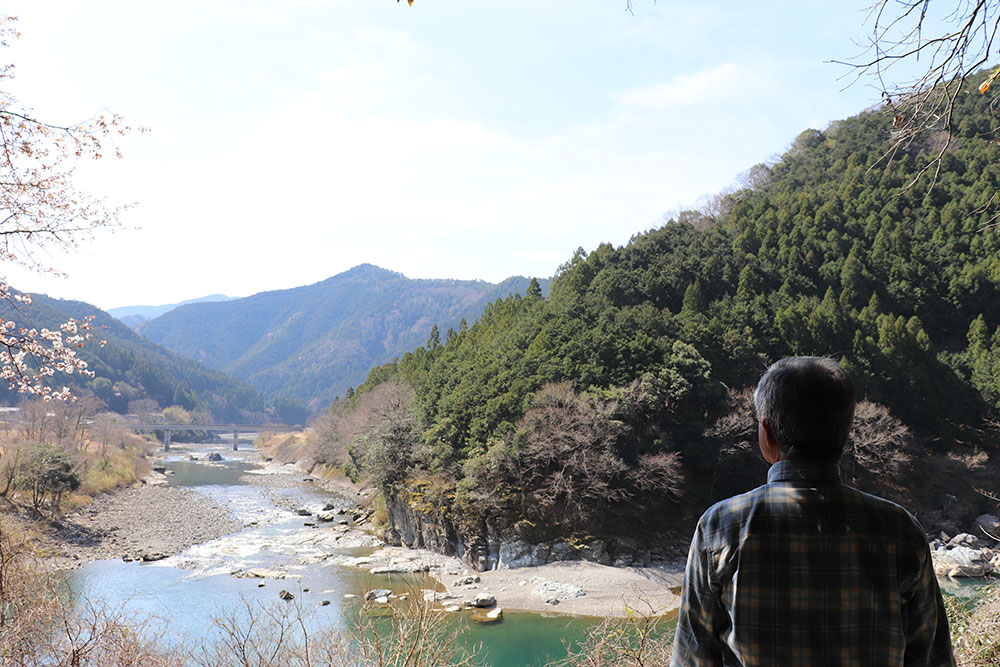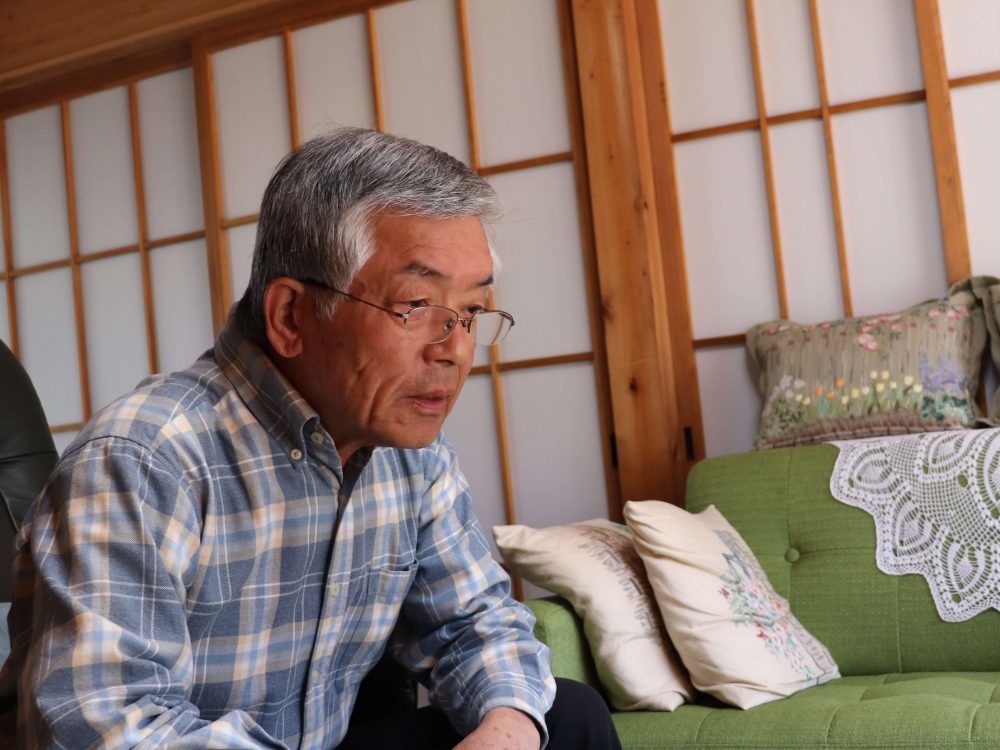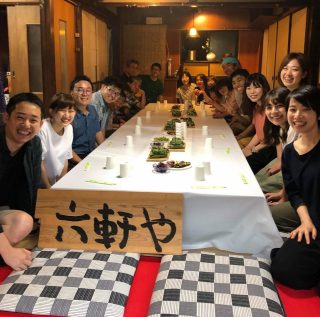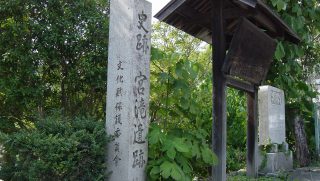“I’ll do it this year!”
So spoke 73-year-old Taisuke Tsujiuchi on a morning in February in the area of Minami-kuzu, Yoshino Town.
It was the day of the Shinto ritual at Kiyomihara Shrine, which enshrines Emperor Tenmu.
Mr. Tsujiuchi plays an important role in performing the dance of the “Kuzu-so” event, which is an Intangible Folk Cultural Property as designated by Nara Prefecture.
He dons a traditional costume featuring the design of a phoenix (this design is said to have been the gift of Emperor Tenmu), and heads for the shrine.

On the path to the shrine, there are steep stone steps which run next to the Yoshino River, but this area is like his own garden that he has known since he was a child. Therefore, even some thin ice on the slope of the path doesn’t bother him.
The people of the Kuzu-so Conservation Society gradually gathered at the Kuzu-so Training Center near the shrine, got dressed in the same traditional costume as Mr. Tsujiuchi, and then proceeded to the traditional stage.
Born in Yoshino
Mr. Tsujiuchi was born and raised in Yoshino.
It was natural for the eldest son to take over the house, so even after he got married at the age of 23, he continued to live in his family home in this mountainous village.
The family’s business was manufacturing disposable chopsticks. The high-quality disposable chopsticks made from Yoshino cedar, which is considered to be one of the three most beautiful forest trees in Japan, is a specialty product of Nara. However, Mr. Tsujiuchi did not inherit the family business, but instead worked as a national government employee until retirement. Now, his children have left home and he lives happily with his wife.
After retirement, Mr. Tsujiuchi wanted to continue working, so he enrolled in the Silver Human Resource Center in the town. He was assigned the task of writing goshuin red stamps for shrines and temples.
Seeing the smiles of the many worshippers when they view his writing is one secret to Mr. Tsujiuchi’s good health.
There are other secrets to Mr. Tsujiuchi as well.

These include the fresh air of Minami-kuzu area, daily field work, seasonal vegetables, and drinking his favorite liquor. Regardless of the type and brand of alcohol, he likes to take his time and slowly enjoy it. With care from his wife, he also prepares snacks and drinks by himself.
Mr. Tsujiuchi also has a far-reaching project that he has been working on since before retirement: to collect and organize documents related to the “history of the Kuzu district” and pass them on to future generations.
Preserve Kuzu-so and pass it on
The “Kuzu-so” event is said to have originated from the people of Kuzu who offered sake and sang a song to the 15th Emperor, Ojin. It is said that 400 years after that, when the prince O-amano-mikoto (later Emperor Tenmu) fled to Yoshino over a conflict for the succession to the throne, the people of Kuzu welcomed him with singing and dancing.
Emperor Tenmu raised an army in Yoshino and won the throne. The story of this conflict was passed onto future generations and became known as the “Jinshin War,” which stirs up feelings of historical romance.
Mr. Tsujiuchi, who has participated in the traditional “Kuzu-so” event for over 50 years and is also a member of the Kuzu Conservation Society, has a strong desire to know more about the history of the Kuzu district. He regularly goes to the library, talks to the local people, and collects information, writing it down in a booklet, which is his treasure.

His efforts became known to people studying the history of Yoshino as well as those in the media, and when Yoshino was featured in the Japanese TV program “Discovery of the World’s Mysteries!” he was interviewed. At that time, he played the role of explaining the “momi” that appears in the lyrics sung during Kuzu-so.
“Momi,” a red frog that was once considered a delicacy in this area, came up as a topic in a quiz on the program, which made for lively viewing.
However, Mr. Tsujiuchi is grateful for receiving the quiz evaluation and with the members of the Kuzu-so Conservation Society, he still continues to search for how to discuss “Kuzu-so” and how it can be connected to the future.
Epilogue
Surrounded by mountains, Yoshino has a relaxing atmosphere.
However, Mr. Tsujiuchi sometimes feels like something is different from the era of his childhood. The natural environment seems to change little by little.
It is difficult to go back to the old days. While Mr Tsujiuchi thought “There should be something that can be done now,” Yoshino Town joined the “Most Beautiful Village Coalition in Japan” organization to increase the brand power of the town.
There are 64 municipalities and regions affiliated with this organization, and each region aims to increase value in their regions by protecting and utilizing the landscape, environment and traditional culture.
Of course, Mr. Tsujiuchi also took initiative in participating as an activity member. Yoshino Town is blessed with historical and tourism resources. To ensure that those resources remain in the future, he wants to do what he can now.
Based on this belief, he has gradually expanded the scope of his activities together with other members. Projects of his include setting up signboards to promote aesthetics and creating a handwritten guide map of the Kuzu district.

And now, what he is aiming for in his seniority, is to be a storyteller. Needless to say, he wants to tell the historical story of the Kuzu district. Mr. Tsuijiuchi likes to express himself in public and set goals for his speaking:
“In my own words, make it easy to understand, and in a natural tone…”
With these ideas in mind, he is now planning every day about how to go about being a good storyteller.
This is the spirit of a person born in Yoshino, and it is a real pleasure to experience.
I look forward to your success!



